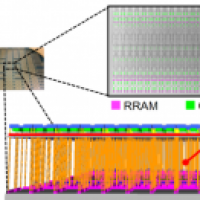
At this week’s ISSCC conference in San Francisco, a group of researchers from Stanford, Berkeley, and MIT, demonstrated a novel device based on 1,952 carbon nanotube FETs and 224 resistive RAM cells fabricated using a monolithic 3D process. The team demonstrated an end-to-end brain-inspired hyperdimensional (HD) computing nanosystem, effective for cognitive tasks such as language recognition, using heterogeneous integration of multiple emerging nanotechnologies.
The team was led by Stanford Professors H.-S. Philip Wong and Subhasish Mitra, and their students, T. F. Wu and H. Li, who have been funded in part by the Stanford SystemX Alliance. Additional funding was provided by DARPA, NSF/NRI/GRC E2CDA, STARnet SONIC. The collaborators include the teams of Prof. Jan Rabaey (UC Berkeley) and Prof. Max Shulaker (MIT).
Brain-Inspired Computing Exploiting Carbon Nanotube FETs and Resistive RAM: Hyperdimensional Computing Case Study
T. F. Wu1, H. Li1, P-C. Huang2, A. Rahimi2, J. M. Rabaey2, P. Wong1, M. M. Shulaker3, S. Mitra1
1Stanford University, Stanford, CA
2University of California, Berkeley, Berkeley, CA
3Massachusetts Institute of Technology, Cambridge, MA
Carbon nanotubes meet resistive RAM cells

https://www.eetimes.com/document.asp?doc_id=1332971&_mc=RSS_EET_EDT


